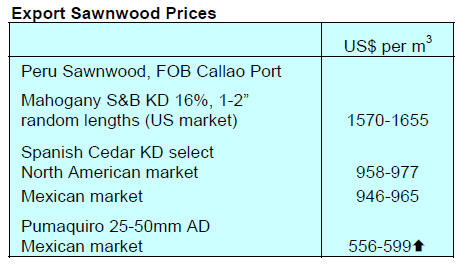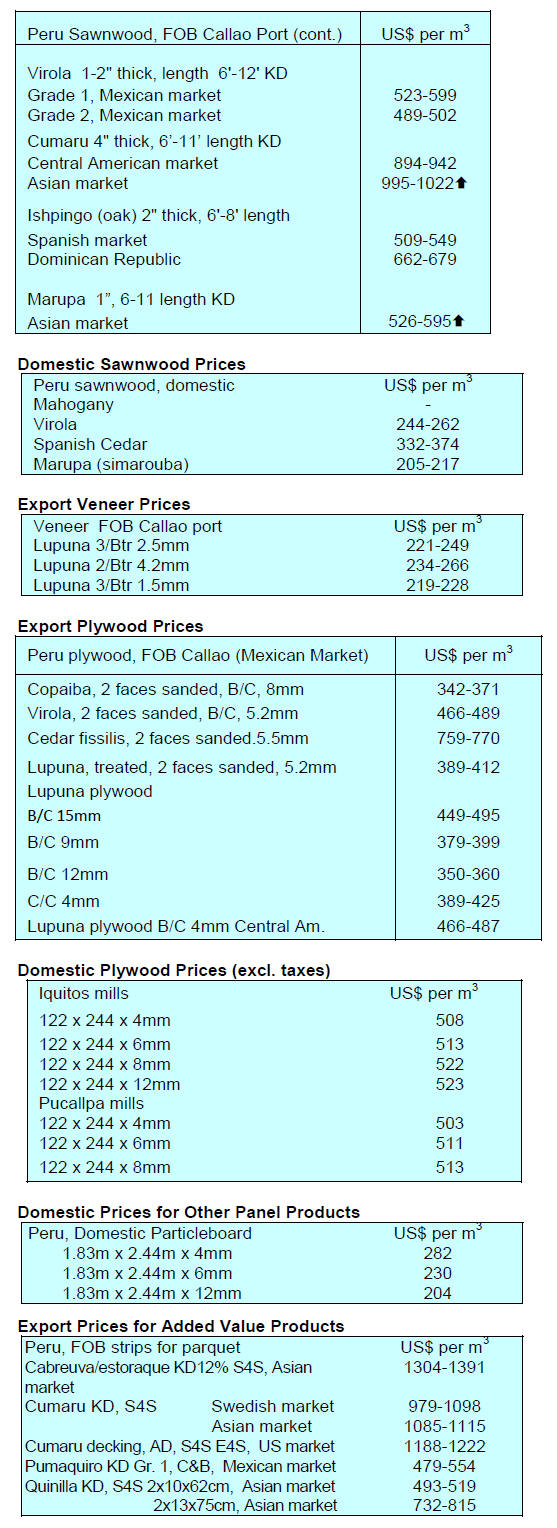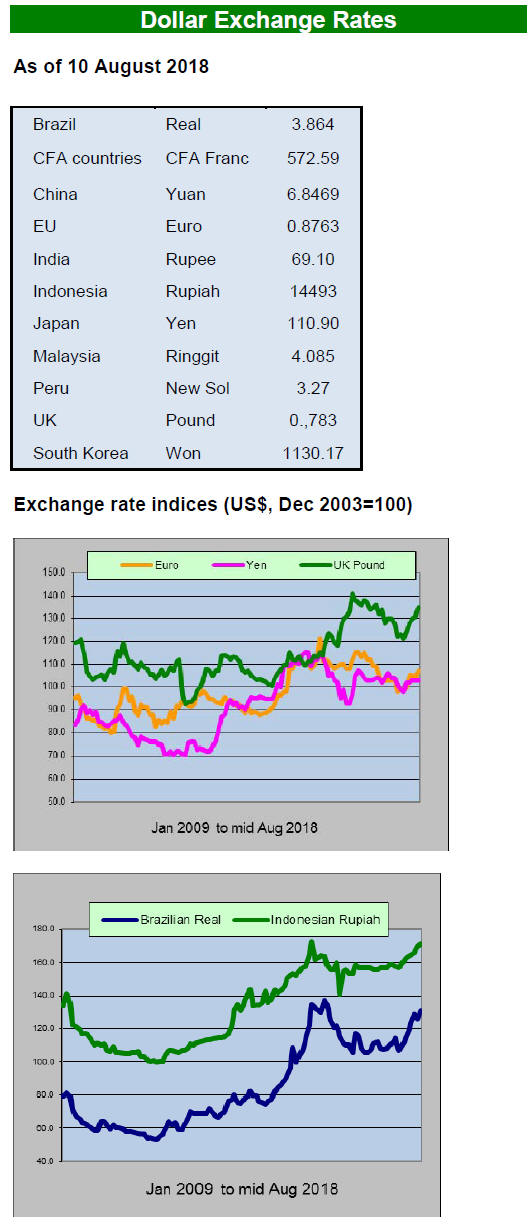2. GHANA
Encouraging growth in sawnwood exports to Asian
markets
Ghana’s wood product exports in the first five months of
2018 recorded a year-on-year growth in both volume and
value according to available data from the Timber
Inspection Development Division (TIDD) of the Forestry
Commission.
The country exported a total of 144,300 cu.m of wood
products between January and May 2018 to register a 24%
growth when compared to 116,952 cu.m exported in the
same period in 2017. Total export revenues for the first
five months of 2018 also improved, rising 38% to Euro
86.32 million from Euro 62.65 million in 2017.
According to the TIDD, secondary wood products
accounted for close to 88% of the total export volume in
2018 followed by primary wood products at 10% while
tertiary wood products accounted for the balance the
details are in table below;

Primary wood product exports (poles and billets)
expanded 81% from 8,045 cu.m in 2017 to 14,540cu.m in
2018. Exports of secondary wood products, mainly
sawnwood, boules, veneer and plywood also increased
22% while exports of tertiary wood products declined.
The major markets were in Asia with smaller quantities
going to neighbouring African countries. Planation teak,
rosewood, ceiba, papao/apa and wawa were some of the
leading species utilsed for exports.
Distressed banks merged – a move welcomed by
industry associations
The Ghana Central Bank has announced that the
government has taken control of 5 distressed local banks
and merged them into a single entity known as the
Consolidated Bank.
Governor of the Central Bank, Dr. Ernest Addison, said
this action is part of ongoing reforms aimed at
strengthening the country's financial sector. The new
entity has benefitted from an almost US$90 million
recapitalization.
The Association of Ghana Industries (AGI) said it was
hopeful the Central Bank would be able to get the new
financial institution on a sound footing to service the needs
of industry.
In related news, a press release from the AGI said “the
Association notes with concern, related developments in
the Ghanaian economy and reiterates that the influx of
imports remains a major risk to the growth of industry and
the country’s job creation prospects.
Instances of weak local currency and exchange rate
volatilities as experienced in the second quarter reflect the
import-oriented nature of our economy. Businesses came
under intense pressure from cedi depreciation in Q2.
Speculations about new taxes emerging in the mid-year
budget review negatively impacted business confidence.”
See:
https://agighana.org/uploaded_files/document/b6cd3083881d1d7
4f7ec00c3fc03eefe.pdf
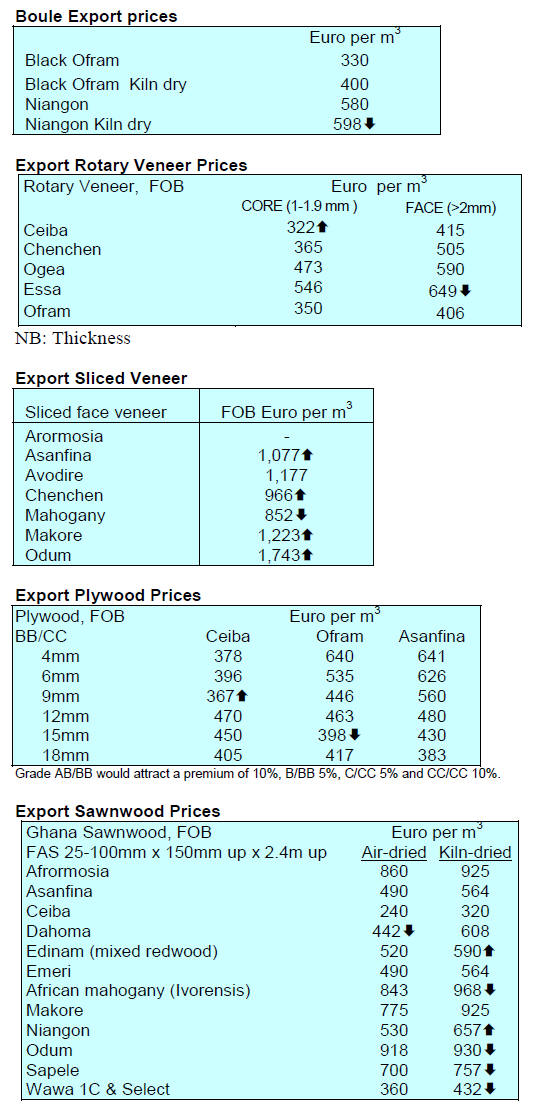
3.
MALAYSIA
MTC has new chairman
Dato’ Low Kian Chuan has been appointed Chairman of
the Malaysian Timber Council (MTC). Dato Low, 58, who
holds a Bachelor of Economics and an Advanced Diploma
in Business Administration started his career in the timber
industry working in his father’s sawmill in Terengganu
shortly after graduating from the university in 1984.
He is currently the Executive Chairman of Low Fatt Wood
Group of Companies. Low has a long history with the
timber industry which revolves around his involvement in
the Timber Trade Federation Malaysia (TTFM).
Established in 1957, TTFM was one of the pioneer
organisations that consolidated and brought together those
in the timber sector, especially the sawmillers. It was also
one of the key associations instrumental in the formation
of MTC.
Among Low’s notable achievements was promoting the
idea of producing premium grade laminated scantlings or
lam-scants. Low initiated the R&D to produce high grade
lam-scants for niche markets, which resulted in the 2004
registered trademark ‘Lamtec Malaysia’, a label for
premium wooden laminated scantlings.
Low’s vast exposure and experience in the timber industry
and other sectors will further elevate MTC as an
organisation that advances the collective interest of its
stakeholders.
See:
http://www.mtc.com.my/images/media/625/Press_Release_on_A
ppointment_of_Chairman_-ENG-_Final.pdf
Furniture exports continue to expand
The Malaysian Timber Industry Board (MTIB) has
reported that the timber industry contributed RM23.2
billion to export earnings last year representing an almost
5% increase from a year earlier. Of the total RM8 billion
was from the export of furniture of which 80% was
rubberwood furniture. The MTIB has targeted a 3-5%
growth in wooden furniture exports for 2018.
The Director General of MTIB, Dr. Jalaluddin Harun, said
the Board aims to modernise the timber industry through
automation and increased productivity so as to reduce the
industry’s reliance on semi-skilled foreign labourers.
Malaysian Forestry Conference (MFC)
The 18th MFC was hosted by the Forest Department of
Sarawak and the Sarawak Forestry Corporation. The MFC
is held every three years on a rotational basis amongst the
Forestry Departments of Sarawak, Sabah and Peninsular
Malaysia. The Conference provides a forum for Malaysian
foresters to exchange and share information, views and
experiences in the administration, management and
developments of the nation’s forest resources.
Sarawak Chief Minister, Abang Johari Tun Openg, told
the MFC that the Sarawak government has made it
mandatory for all holders of long-term forest timber
licenses to obtain Forest Management Certification by
2022. He said the decision is in line with the state’s policy
reform.
He acknowledged that achieving certification in the State
will be a challenge especially in terms of the capacity of
both implementing agencies and the private sector.
However, through good collaboration between State
agencies, timber companies, the associations, NGOs and
local communities a balance between environmental
protection, economic growth and socio-economic
development can be achieved.
One major challenge will be how to secure land for
development without encroachment into the permanent
forest estate. This will require a review of policies and
ordinances to strengthen forest management and
protection.
Sarawak and Vietnam cooperation on furniture
KTS Holdings and Pusaka Timber Industries (PTISB),
both from Sarawak, signed memorandums of
understanding with Sudima Panels and Wilsons Hill
Vietnam to collaborate on furniture manufacturing.
The Sarawak companies have recognised the success
Vietnam has achieved in utilising acacia to produce
furniture. Currently, Sarawak’s export of furniture is
negligible, contributing less than 5% of total export
earnings by the timber sector. Sarawak has plans to
establish one million hectares of industrial forest by 2020.
As of December 2017, 400,000 hectares have been
planted, mostly with acacia.
July plywood prices
Plywood traders based in Sarawak reported the following
export prices:
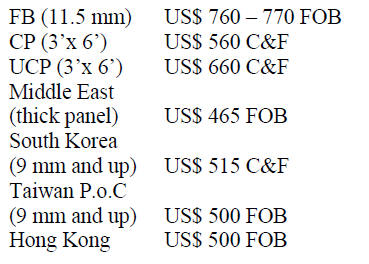
4.
INDONESIA
Non-tariff barriers to hold
back imports
In response to rising global trade tensions and a fear that
Indonesia will become a target market for goods no longer
competitive in the US market the government is
considering ways to limit certain imports through nontariff
means.
The media in Indonesia has reported that Gati
Wibawaningsih from the Ministry of Industry has said that
while the government cannot ban imports of particular
products it must act to protect domestic industry.
See: https://nasional.kontan.co.id/news/pemerintah-menyiapkannon-
tariff-barrier-untuk-menahan-guyuran-impor
Indonesia hopes US will maintain GSP facility
The Indonesian President has expressed the hope that the
US would not revoke the Generalised System of
Preference (GSP) facility for Indonesia. He reminded the
US that over half of the items Indonesia exports to the US
are raw materials for US companies.
Since 2011 Indonesia has enjoyed GSP benefits but the
prospect that the US administration plans to review over
100 products from Indonesia including textiles, plywood,
cotton and several marine products is of considerable
concern.
Manufacturing output up 4%
Industry Minister, Airlangga Hartarto, has reported that
manufacturing output increased 4.4% year-on-year in the
second quarter of 2018. This was higher than 3.9% growth
recorded in the the second quarter of last year. Airlangga
said the manufacturing sector is the backbone of the
country’s economy.
The press release from the ministry reported the natural
rubber sector was the largest contributor to the economy
excluding the oil and gas sectors followed by the leather
and shoe sectors, food and beverages and textiles.
In contrast to the second quarter growth, during the first
time in six months of 2018 manufacturing output declined
as domestic demand weakened and demand in overseas
markets continued to soften.
Forestry staff to study monitoring of production
forests
Staff in the Ministry of Environment and Forestry
(KLHK) Directorate General of Sustainable Production
Forest Management (DG PHPL) will benefit from
‘StuNed’ scholarships and will travel to the Netherlands to
undergo training in monitoring production forests using
spatial technology in remote forest areas. The training will
take place at the University of Twente.
Good prospects for Indonesia's ‘Green Bond’
The World Bank has estimated the potential in Indonesia
for environmental theme funding through green bonds and
sukuk (sharia compliant bonds) and said these could reach
around US$27 billion by 2030.
Philippe Le Houérou, Chief Executive Officer of the
International Finance Corporation, said Indonesia faces
serious challenges in environmental conservation and
there is a great opportunity for the development of
innovative financial tools to support conservation work.
Five point plan for Indonesia’s forestry sector
development
The Ministry of National Development Planning has
produced an assessment of what is required for Indonesia's
forestry sector to contribute more to the national
development agenda.
Arifin Rudiyanto, Deputy for Maritime and Natural
Resources, has said the assessment has five main targets,
namely rationalising the area and forest cover, improving
the economy of forest-based communities, optimising bioeconomic
based multipurpose forests, forest management
and the realisation of good forest governance.
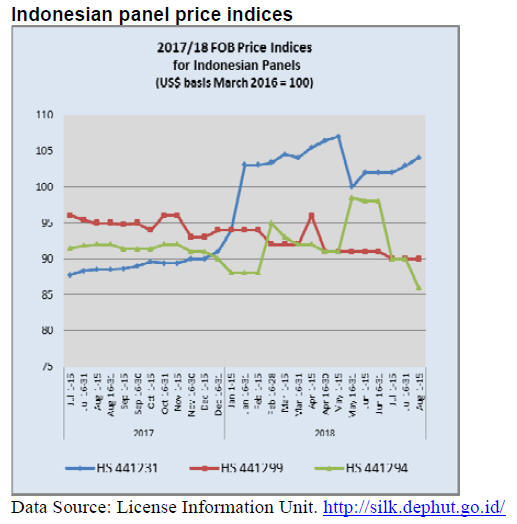
5.
MYANMAR
Launch of third party certification
According to the domestic media the Myanmar Forest
Certification Committee (MFCC) launched its Third Party
Certification System at an 8 August workshop in Yangon.
It is reported that there are four Certification Bodies, three
local and one international, which will issue Legality
Compliance Certificates under the Myanmar Timber
Legality Assurance System (MTLAS).
Barber Cho, Secretary of the MFCC, explained that the
MTLAS Gap Assessment Project conducted in 2016-17
with the assistance of the EU and FAO recommended
MFCC to initiate a system of third party certification. The
Ministry of Natural Resources and Environmental
Conservation (MONREC) assigned the MFCC to
implement this.
To proceed the MFCC contracted international consultants
to design the documentation tracking system and to
conduct auditor training under an MFCC-PEFC supported
project in order to strengthen the MTLAS. This effort was
funded through a grant from the Prince Albert II of
Monaco Foundation.
Cho explained that the MFCC has worked hard to
overcome the challenges to achieve its aim but that the
MFCC still has more to do to make the MTLAS credible
and internationally recognised.
Greater transparency is high on the agenda of the MFCC.
At a recent meeting in Brussels several Competent
Authorities (CAs) complained of the lack of information
being provided by Myanmar. To improve transparency
and access to information the MFCC has launched a
website http://www.mfcc.com.mm.
The Myanmar Timber Enterprise also has a website
(www.myanmatimber.com.mm) and the Secretary of the
MFCC has urged the EU CAs to access these sites. A
recent ‘hit’ analysis showed that few entities in the EU
have been accessing the information that is available
seeming to prefer to rely on third party sources. Cho
appealed to the CAs in the EU to avail themselves of the
latest information.
Bamboo resources waiting to be utlised
The MTE has announced through their website an
invitation to investors. The invitation reads “With the
growing shortage of raw materials around the world and
maximised contribution required of the forestry sector to
the national economy, priority is being given to
downstream processing and value added production
investments.”
The MTE is encouraging the use of lesser known species
and bamboo saying bamboo is an inexhaustible resource
especially for pulp and paper, bamboo chips and other
uses.
MTE says investors interested in bamboo based industries
could consider Rakhine Yoma for its abundant supply of
bamboo and easy access to the sea. The MTE also says
over 60 million pieces of rattan are available from
rainforests of Myanmar yet no serious efforts have been
made to develop this industry.

6. INDIA
Surge in residential sales in top
seven cities
A recent press release from CREDAI provides an
overview of their August CREDAI NATCON 2018
(CREDAI’s national convention) at which over 1,000 real
estate developers from 100 Indian cities discussed
challenges and opportunities against the backdrop of
tremendous growth in residential sales.
Participants reviewed reports which focused on the
unprecedented growth displayed by the real estate industry
in India which showed a 25% year on year rise in sales.
At the convention CREDAI revealed demands for
incentives for developers to participate in affordable
housing to continue the growth in this sector. The
demands included enabling tax benefits, reducing land
area utilisation to 50% and a 12% GST.
According to CREDAI these demands if met would
provide further impetus to the growth of the real estate
sector amidst the positive trends on investments and
residential housing.
The growth witnessed in the fist half of 2018, according to
CREDAI, can be attributed to two main factors, firstly an
improvement in buyers’ confidence on account of
implementation of the Real Estate Regulation and
Development Act (RERA) in most states and stable capital
values that have started to show an upward bias.
These two factors have pushed many fence sitters and new
home buyers to take the purchase decision. This is despite
the fact that the Reserve Bank of India increased interest
rates in the third monetary policy meeting making
borrowing for home loans dearer.
The general consensus amongst the buyers has been that
the markets have bottomed out and capital values are now
expected to rise.
For more see: https://credai.org/press-releases/credai-jll-reportreveals-
25-surge-y-o-y-in-cumulative-residential-sales-in-topseven-
cities-of-india-in-h1-2018-at-natcon-2018-berlin
Plantation teak
Demand for imported logs has started to improve and this
has given traders the opportunity to raise prices on the
local market by between 8-10%. However, this change has
not resulted in any change in C&F prices.
The banks in India are coming under mounting pressure to
resume import credit facilities and even the Reserve Bank
of India has asked them revive the facility quickly.
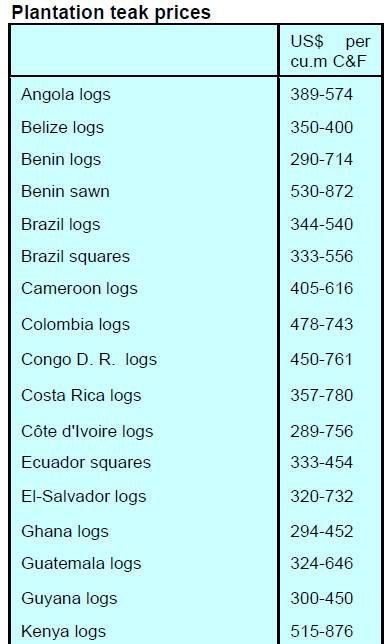
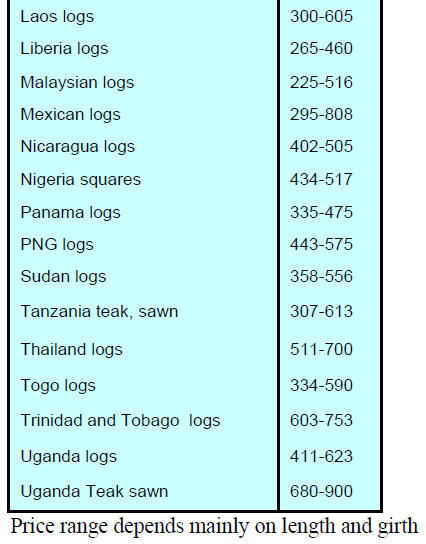
Locally sawn hardwood prices
As the housing market has started to improve demand for
timber has also been rising which provides a welcome
opportunity for importers to begin raising prices to off-set
the weakness in the rupee/dollar exchange rate.
Prices in the domestic market have been increased as
shown below.

Imported sawn Myanmar teak
Ex-yard prices for imported sawn Myanmar teak have
been increased on the back of improved demand.
Confidence in the housing market has also lifted prices for
Myanmar teak finally giving traders with large teak stocks
to secure some sales. As stock levels fall analyst write
further price increases are likely.
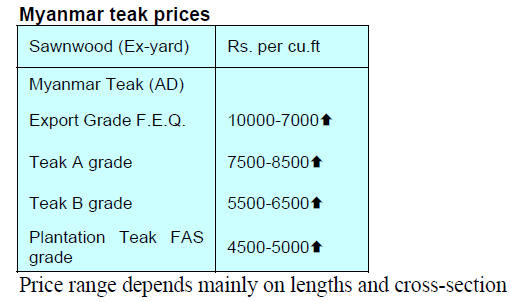
Locally sawn hardwood prices
Prices for imported kiln dry sawnwood have been raised
for the first time in months.
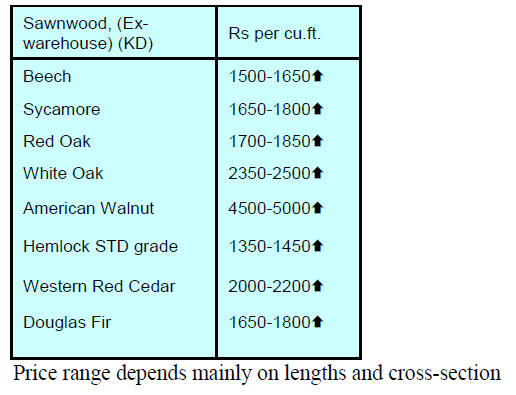
Plywood up-date
Plywood manufacturers report satisfaction with the market
acceptance of the recent price increases.
Analysts write that manufacturers are contemplating
increasing prices by another 5% which will help them
contend with the rising costs of raw materials and revive
their profit margins which have suffered for almost all of
this year.
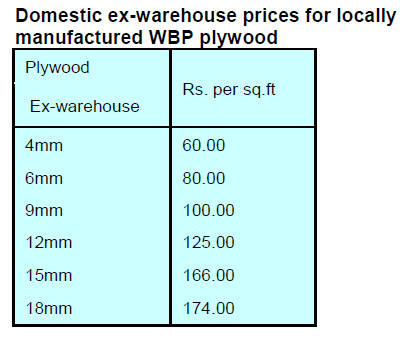
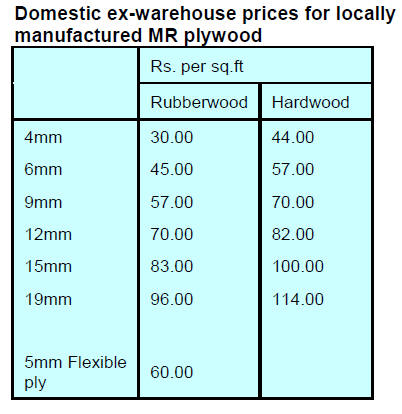
7. BRAZIL
Future of the forest debated
More than 20 industry federations from all over Brazil,
governmental authorities, and forestry sector stakeholders
attending the 106th meeting of the Thematic Council on
Environment and Sustainability (COEMA) part of the
National Industry Confederation (CNI) recently debated
the future of the forest in Brazil.
On the agenda was the National System of Control of the
Origin of Forest Products (SINAFLOR) and discussions
focused on the many problems in implementation.
According to the Federation of Industries of the State of
Rondônia (FIERO), the SINAFLOR platform is not
working properly in Rondônia. FIERO highlighted the
prospects of logging in the state under forest management
plans; adding that "the state should promote the image of
forest management as a differential and show the
consumer market that the only way to undertake controlled
exploitation/logging is through forest management."
In addition, FIERO says enterprises in Rondônia face
difficulties because IBAMA will not authorise
management plans for forests where there is no land title.
This has eliminated vast harvestable forest areas from
commercial use and seriously jeopardised companies in
Rondônia as around 80% of the industrial roundwood
comes from forest areas with only rights of possession.
The COEMA Council has become an important venue for
debate and provide participants with the opportunity to
identify issues of concern and offer solutions.
Logging law needs reviews
In July this year the ‘Normative Instruction No. 005/2014-
SEMA’ came into effect. Article 9, paragraph 1,
establishes that the minimum cutting diameter (MCD)
shall be 0.60m.
The authors worked on the Instruction for 4 years and
were required to provide technical and scientific reasoning
to support the legal requirement but forestry sector
stakeholders claim none were submitted to justify the
60cm blanket limit. The apparent arbitrary increase in
minimum diameter will result in many species being
eliminated from the harvest because even at maturity they
do not reach a diameter of 6ocm.
The Forestry Technical Chamber – CTF (Câmara Técnica
Florestal) composed of several entities such as SEMA
(State Secretariat of Environment), IBAMA (Brazilian
Institute for Environment and Renewable Natural
Resources), SEDEC (State Secretariat for Economic
Development), FAMATO (Federation of Agriculture and
Livestock of Mato Grosso), AMEF (Association of Forest
Engineers of Mato Grosso), OAB (Brazilian Bar
Association), UFMT (Federal University of Mato Grosso),
AREFLORESTA (Mato Grosso Reforestation
Association) and CIPEM (Center for Timber Producers
and Exporters of Mato Grosso State) drafted an
amendment for IN No. 005/2014 based on scientific
studies developed by the Brazilian Agricultural Research
Corporation (EMBRAPA) and with unanimous agreement
of all CTF members.
The group is calling for revoking Article 9 of the
Normative Instruction and redrafting to make it consistent
with the decrees and resolutions of the National
Environmental Council - CONAMA.
Panel export growth
The 50th IBÁ Report produced by the Brazilian Tree
Industry (IBÁ) indicates that there was an increase of
8.6% in wood panel exports in the first six months of
2018. The main markets in June continued to be Latin
America (US$78 million), North America (US$38 million)
and Asia / Oceania (US$18 million).
However the report notes a 28% decline in exports to
Africa, falling from US$7 million to US$5 million year on
year but there was an increase in exports to Europe.
In terms of domestic sales, after the sharp decline recorded
in May, domestic sales picked up in June with some 3
million cu.m being sold. Domestic sales increased almost
2% in the first half of 2018 compared to the same period
in 2017.
Business to business meetings generate US$3 million
in orders
The Bento Gonçalves Furniture Industries Union
(SINDMÓVEIS) coordinates business dialogues as part of
its ‘Orchestra Brazil’ project the aim of which is to
encourage exports of furniture in partnership with the
Brazilian Agency for the Promotion of Exports and
Investments (Apex-Brasil). The latest activity of
‘Orchestra Brazil’ was during the ForMóbile held in São
Paulo.
See:
https://www.formobile.com.br/pt/home.html
The ‘Orchestra Brazil’ project was established in 2006 and
promotes competitive marketing of Brazilian wooden
furniture in international markets.
During the ForMóbile fair more than 200 business to
business meetings were arranged between Brazilian
companies and importers from eight countries, such as
South Africa, Argentina, Bolivia, Chile, Colombia,
Mexico, Paraguay and Peru. Business deals worth around
US$230,000 were concluded with a forecast of almost
US$3 million in sales over the next 12 months.
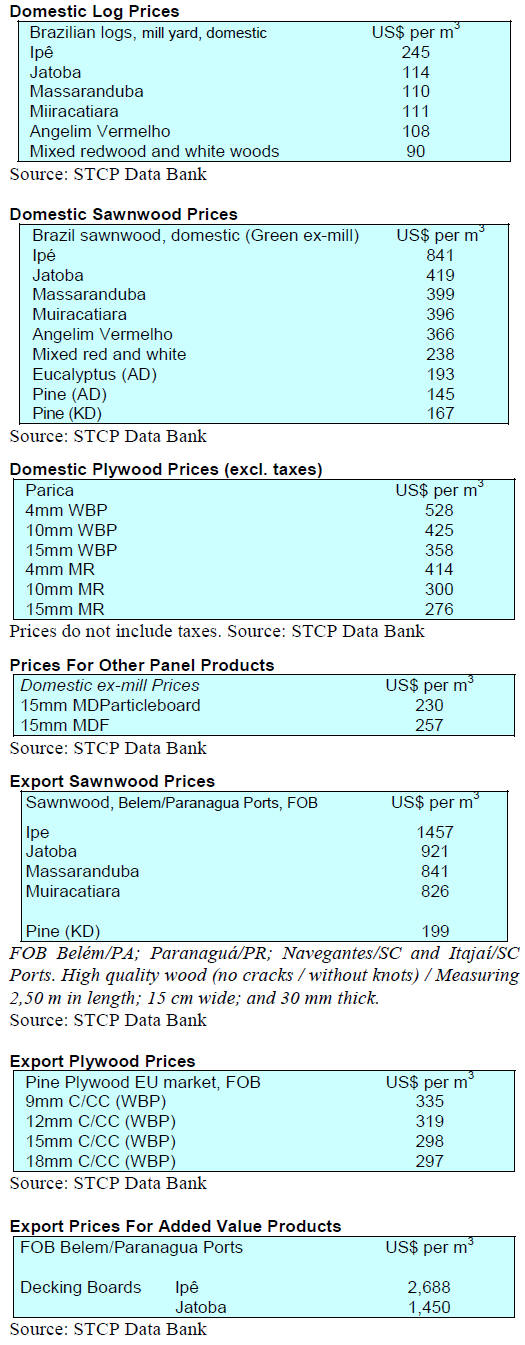
8. PERU
China scales back flooring
purchases
The Association of Exporters (ADEX) has reported that
Peruvian exports of wooden flooring were worth US$23.8
million in the first four months of 2018 but that this was
down 6% year on year. The main export items were
tongue-and-groove flooring and decking.
During the first four months of this year wooden flooring
exports went mainly to China which accounted for over
half of all flooring exports but this was down almost 20%
compared to the same period in 2017.
The other markets of note were France (US$3.7 million),
the United States (US$1 million) and smaller quantities
were shipped to Belgium, Denmark, Germany, Mexico,
Australia, New Zealand and the Netherlands.
The main exporters were IMK Maderas S.A.C., Grupo
Maderero Amaz S.A.C., Maderera Bozovich S.A.C., E & J
Matthei Maderas del Perú S.A. and Forest Industry
Huayruro S.A.C.
Shihuahuaco captures the attention of buyers
While overall sawnwood exports have declined over the
past three years some companies have increased business
in international markets.
One such company is Maderacre SA which has focused on
developing wooden flooring. For many years mahogany
was the most demanded timber but today it is shihuahuaco
(Dipteryx micrantha) that has captured the attention of
buyers.
Executive boards to be revived
The Ministry of Production has announced that the system
of Executive Boards will be expanded to more sectors.
Speaking on this the Minister of Economy and Finance,
Carlos Oliva, said he considers it important to reactivate
the Executive Boards to strengthen coordination between
the public and private sectors.
The Government will soon publish its competitiveness
strategy which will focus on structural, reforms to raise
competitiveness. In promoting the idea of Executive
Boards he pointed to the success of the Forest Executive
Board which is helping development of the forestry sector.
